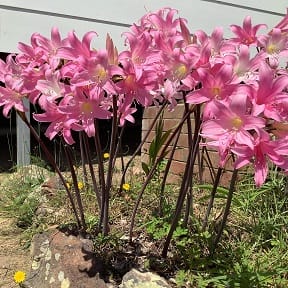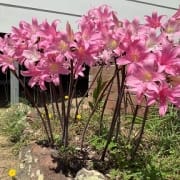What’s in a name?
As gardeners, we should all try and learn the botanical names of our plants as well as their common names. The reason is that because the same common name sometimes applies to multiple plants and, conversely, a single plant may have multiple common names! Knowing the botanical name helps to remove any confusion, especially when you are talking to other plant lovers.
Each botanical name is unique to that species and is composed of two, (usually) Latin words: a genus name (always capitalised) followed by a species name (lower case). The genus name is like your surname. It tells you which plant group (based on flower appearance) a specimen belongs to (Eucalyptus, Banksia, Camellia etc.). The species name is like your first name: it is unique to that plant in the genus and is often descriptive. For example, the species name rubra means red, tomentosa means hairy, japonica from Japan and grandiflora large-flowered). So, whilst a genus name may apply to many different plants (think of all the different Grevilleas for example) and the same species name may apply to plants from several different genuses (think Dietes grandiflora, Abelia grandiflora and Magnolia grandiflora), no two plants will ever have the same genus and species names. Hence, Bulbine bulbosa (native leek) will be recognised as such, whether you live in Brogo, Bermagui, Barraga Bay or Berlin.
Meanwhile, around the town gardens, the tough old Nerium oleander (oleander) is continuing to stand out (the white is my favourite) and many bare-stemmed, pink-flowered Amaryllis belladonna (naked ladies) have emerged, seemingly miraculously, from the bare ground ahead of their later leaves. The various hibiscus species continue to brighten the landscape, as do the Plumeria rubra (frangipani) in frost-free areas.
In the wild places on the sides of the road around the Triangle, all is pretty quiet and homogenously green at the moment, with very few native plants noticeably flowering. However, in parts of the cleared farmland areas, I did, however, notice some beautiful low-growing (to around 50 cm) bright-purple swathes of the weed Verbena rigida (veined verbena).
This month in the vegie garden, I will continue to plant peas and I always sow my garlic cloves on Anzac Day. Also, onions. Ever tasted a fresh onion? They are on par with the difference between home-grown and shop-bought tomatoes. Give a row or two a go and experience the joy of a sweet, home-grown onion. In the same family, you can be planting leeks and shallots, although the easiest way to grow shallots is to just plant the leftovers from a bunch of store-bought ones. Keep planting your winter brassicas (broccoli, cauliflower and kale) and your soup staples (swedes and turnips) as well as lettuce and silverbeet for leafy greens. Last chance for beetroot seeds and, if you are in areas away from the frost, keep going with the carrots.
Finally, if you have any comments, gardening questions, or plant or pest identification problems, please send them through to gardening@thetriangle.org.au and I will endeavour to help.
Happy growing!



